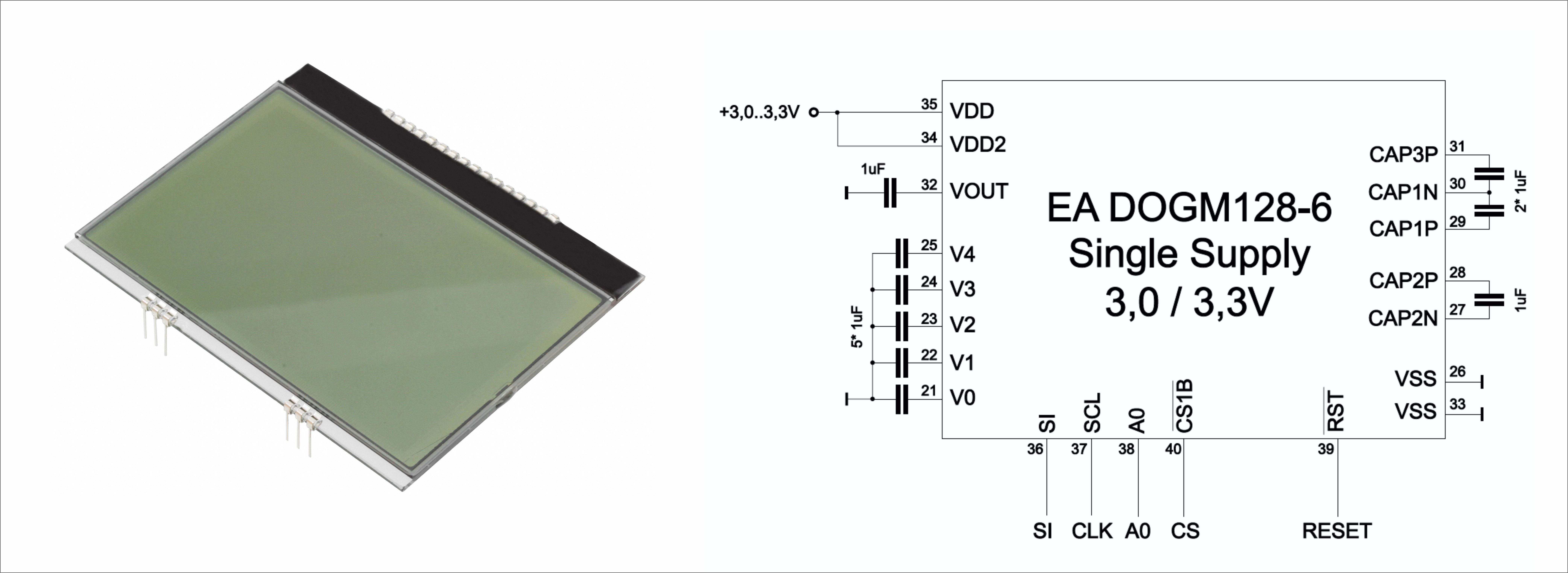A practical implementation of the EmotiGlass concept requires a pixelized light shutter with the following characteristics:
- Spatial resolution of at least 2mm
- Variable opacity and high contrast
- Response speed in the tens of milliseconds or better
After researching possible solutions for fully pixelized electro-optical elements, we settled on modular LCDs for the front lenses. We chose the DOGM128E-6 made by Electronic Assembly GmbH (Zeppelinstraße 19, D-82205 Gilching, Germany) because it allows full control of the pattern of visual occlusion, as well as the opacity level of the occluded and non-occluded areas.

The DOGM128E-6 is sold by Mouser and Digikey (around $23 each). The DOGM128E-6 is a high-contrast, 128x64 pixel LCD supertwist display with 15μm dot gap. It incorporates a ST7565R controller with SPI interface. The display module requires just a single 3.0 to 3.3V power supply (270μA typical) and can be directly mounted on a PCB. The LCD is compact (55x46x2 mm) with a large viewing area of 51x31 mm.
For the side panels we chose the “Small Liquid Crystal Light Valve - Controllable Shutter Glass” distributed by Adafruit as Product number 3627 ($2.95 each). The viewing window is 31x33 mm, while the panel size is 36x36x2 mm, making it suitable to mount on the sides of goggles based on the DOGM128E-6. The device is a transmissive twisted nematic panel and requires an AC drive voltage in the 3.0V range.
To make a first breadboard prototype of EmotiGlass as open-source as possible, we chose the controller to be an Arduino IDE-compatible Adafruit Feather M0 Bluefruit LE (Adafruit Product ID: 2995, $29.95). Power will be derived from a 3.7V 150mAh lithium ion polymer battery (Adafruit Product ID: 1317, $5.95) that can be recharged directly from the Feather.
For the breadboard prototype chose a ready-made plethysmography sensor (Pulse Sensor Amped, Adafruit Product ID: 1093, $25.00). ALS-PT19 Analog Light Sensor Breakout Board (Adafruit Product ID: 2748) is used for the “automatic sunglasses mode”.
A simple oscillator and analog H-bridge will be used to drive the side panels at an amplitude set by two MCP4725A1 DACs are used to control the side-panel shutters (MCP4725 Breakout Board - 12-Bit DAC w/I2C Interface, Adafruit Product ID: 935, $4.95).
 David Prutchi
David Prutchi
Discussions
Become a Hackaday.io Member
Create an account to leave a comment. Already have an account? Log In.